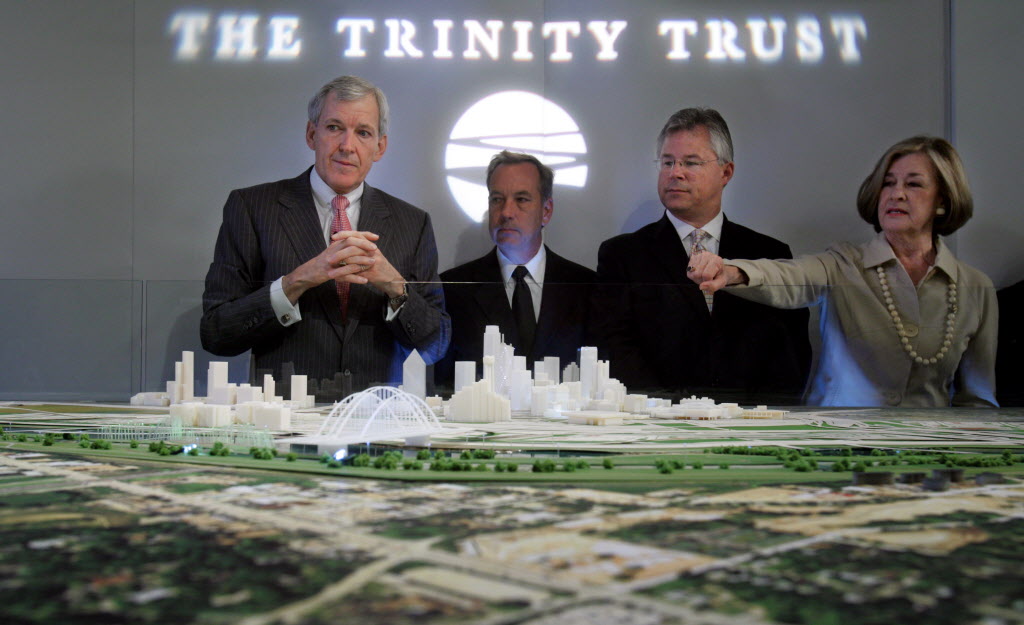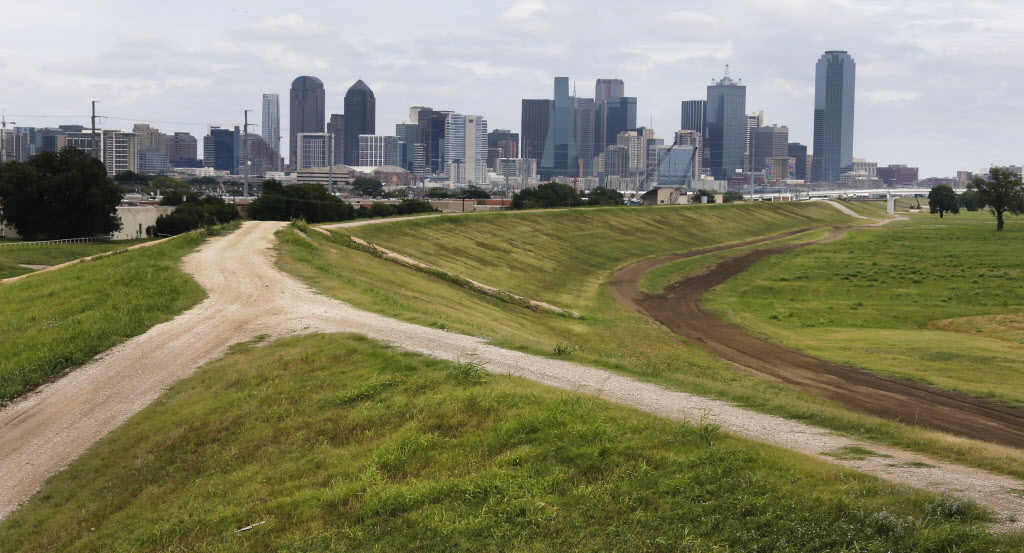10 Things to Know About Trinity Parkway
The ever-divisive Trinity Parkway toll road will be the subject of a town hall meeting at 6:30 p.m. Wednesday at the Chris Semos Campus of Rosemont Elementary School, 1919 Stevens Forest Drive in Dallas. It’s open to the public and doesn’t require an RSVP. Here are the top things you need to know before officials and civic leaders square off about the project, not-so-lovingly dubbed the “zombie toll road.”
1. It Would Connect Irving and Northwest Dallas with Southeast Dallas
Trinity Parkway is planned as a 9-mile road whose western terminus connects to the intersection of Interstate 35E and State Highway 183 and whose eastern terminus connects to U.S. Highway 175 southwest of downtown. It will run roughly parallel to I-35E from Irving to downtown and then will run roughly perpendicular to I-30 as it moves south of downtown.
The road does not have a direct connection to I-30. It won’t connect to I-35E near downtown unless the state builds a connection. That $165 million project is unfunded, but calls for demolishing the current Jefferson Boulevard bridge and replacing it with a viaduct that runs directly from I-35E into downtown. The bridge would intersect with the toll road along the way.
- - - - - -
2. Voters’ Double Approval Isn’t Quite Cut and Dried
The road that voters approved in 1998 was presented as a parkway that would run on both sides of the river and would overlook parks, lakes and recreation areas. What’s being pursued now is a massive highway on the east side of the river whose views of the river-bottom improvements will be blocked by a flood wall.
A second election in 2007, critics say, was confusing because checking “yes” on the ballot meant a voter was against the road and voting “no” meant they were for it.
- - - - - -
3. The Road Isn’t Expected to Dramatically Help Traffic
The road has always been sold as a way to relieve traffic congestion on existing highways that surround downtown Dallas. The road would add 9 percent additional capacity to a 34-square-mile area. But the project’s own traffic estimates show that wouldn’t change the overall amount of congested lane miles. Average speed in the area would only increase 2 miles per hour. There would be a 7.1 percent decrease in hours of delays for the entire area.
- - - - - -
4. Roughly 80 Percent of Funding Hasn’t Been Identified
The road is estimated to cost $1.5 billion, but only about $265 million in funding has been identified. Dallas voters in 1998 agreed to chip in $84 million. The North Texas Tollway Authority has earmarked $40 million. The Regional Transportation Council has agreed to spend $141 million.
The NTTA can throw in more by borrowing against estimated toll revenues, but the agency has long said those projected figured won’t be near enough to cover costs. The NTTA could partner with a private developer to front construction costs. But a company’s expectation for an eventual profit could increase toll rates and the length of time money goes to the firm instead of other transportation projects.
Documents seeking federal approval for the road are scant on financing details. NTTA officials say they will determine a path forward if the project is approved. The estimated $1.2 billion shortfall could force federal and state taxpayers to help shore up construction costs.
“How else are they going to get there?” said State Rep. Rafael Anchia, D-Dallas, who is remaining neutral on the project and is the host of Wednesday’s town hall.
- - - - - -
5. Critics Say Shifting Stories Undercut Officials’ Credibility
Officials in the 1990s hoped the Texas Department of Transportation could make improvements to the interchange of Interstates 30 and 35E and the portion of I-30 south of downtown at the same time Trinity Parkway was being built. Leading up to the 2007 election, though, several officials told the public those projects and improvements to S.M. Wright Freeway couldn’t be done without Trinity Parkway. But TxDOT is currently in the middle of an $800 million redo of the I-30 and I-35E interchange and is moving forward with a $170 million redo of Wright.
As voters prepared to decide the road’s future in 2007, then-Mayor Tom Leppert repeatedly said that federal officials assured him that running the road between the levees would be safe and cost-efficient. Records obtained after the election instead showed that the U.S. Army Corps of Engineers issued a stern warning to the city that it had concerns that the road would jeopardize the levees.
The cost-efficiency of the road is still not known because NTTA has yet to conduct a full-scale feasibility study of the project and has not presented a financing plan to federal officials.
“There’s no trust that’s been developed,” said Brenda Marks, a project critic.
- - - - - -
6. Supporters Say Road’s Impact on Recreation is Sensationalized
Critics say the road will be inhospitable to the parks, recreation areas and lakes the city also plans to put within the Trinity River levees. But project supporters say that’s not necessarily true. Dallas City Council member Lee Kleinman said there is plenty of room for both the road and parkland between the levees. He also said critics over-dramatize what’s currently in the floodplain.
“The reality is we have two levees and a ditch between them, so don’t make them out to be some sort of environmental nirvana,” Kleinman said.
North Central Texas Council of Governments transportation director Michael Morris, who also supports the road, said part of the $141 million his agency has set aside for the project will go toward a pedestrian overlook near downtown.
“I don’t hear a lot of people talking about that,” he said.
- - - - - -
7. Despite Wall, Road Could Still Flood
The road will run inside the Trinity River levees for about 6.2 miles. There will be a flood wall between it and the river for about one-third of that length, near downtown. But the road could still flood in a 100-year storm. Such an occurrence would put Trinity Parkway out of commission for five days so that $3.2 million worth of maintenance could be done to reopen it. The possibility would also require an evacuation plan for the road.
- - - - - -
8. Influence of Design Summit Not Certain
Mayor Mike Rawlings last month announced that six renowned urban planning and transportation experts will convene in Dallas to re-think the Trinity Parkway as designed. He said it will provide a chance for detailed criticisms to influence the finished product. It remains unclear how dramatically the panel will be able to change things. If the panel appeases critics and suggests major changes to the road’s width, placement or support structures, the city could have to reject the recommendations or delay federal approval.
The experts’ recommendations could also affect financing that is already shrouded in uncertainty. The NTTA already estimates that it won’t be able to borrow enough against tolls generated from the larger design to cover all construction costs. But if the high-speed, mostly-six-lane design is scaled back, estimated toll revenues would almost certainly drop from current expectations. Other design elements that are added to make the road and its flood wall more serene could also drive up overall costs.
- - - - - -
9. Building Small Doesn’t Mean Staying Small
Morris and former City Manager Mary Suhm have said officials are considering a “phased approach” to the project. And next week’s design summit could yield a road that is more like the parkway originally described to residents. That would mean fewer lanes that could also be narrower than what is currently designed. It could also mean slower speeds. But even if the project starts small, that doesn’t mean it will stay that way.
The project’s environmental documents seeking federal approval show a road that’s typically six lanes across, but could be at least nine lanes wide at some points. Once the Corps and Federal Highway Administration give approval, the city and NTTA have all the authority they need to eventually build the road as wide as what’s shown in the environmental documents.
Plus, a smaller road with slower speeds would raise further questions about how effective the road would be at bringing the traffic relief that supporters say is desperately needed.
- - - - - -
10. The Road’s Fate Could Take Several Routes
Several hoops must be jumped through before the road can be built. The Corps and FHWA both must sign-off on the project. If either entity rejects the road, the Trinity Parkway as imagined would likely be dead. Those agencies are currently mulling their respective decisions.
If the entities approve the project, NTTA still has to do a comprehensive financial feasibility study to zero in on how much of a shortfall there is on the project. Then that entity, the city and other government agencies and/or private companies would have to come together to fill the gap. A state transportation commissioner has already said he doesn’t want TxDOT ensnared in that process.
NTTA and the city have an agreement in place to build the road, but a city attorney for Dallas has said it is likely no longer enforceable, meaning either side could likely drop out of the project. NTTA officials haven’t challenged that assessment or sought their own legal opinion.










